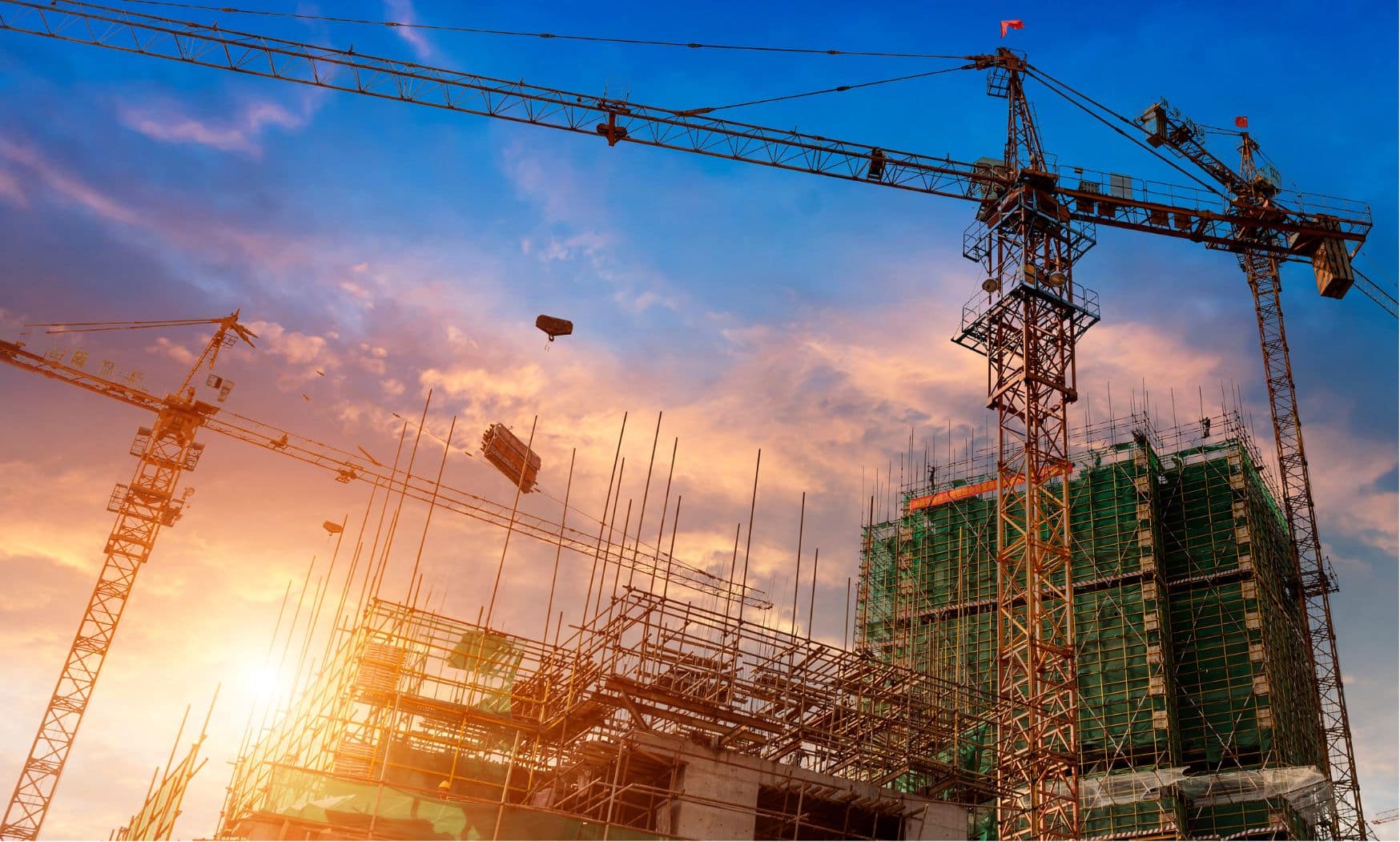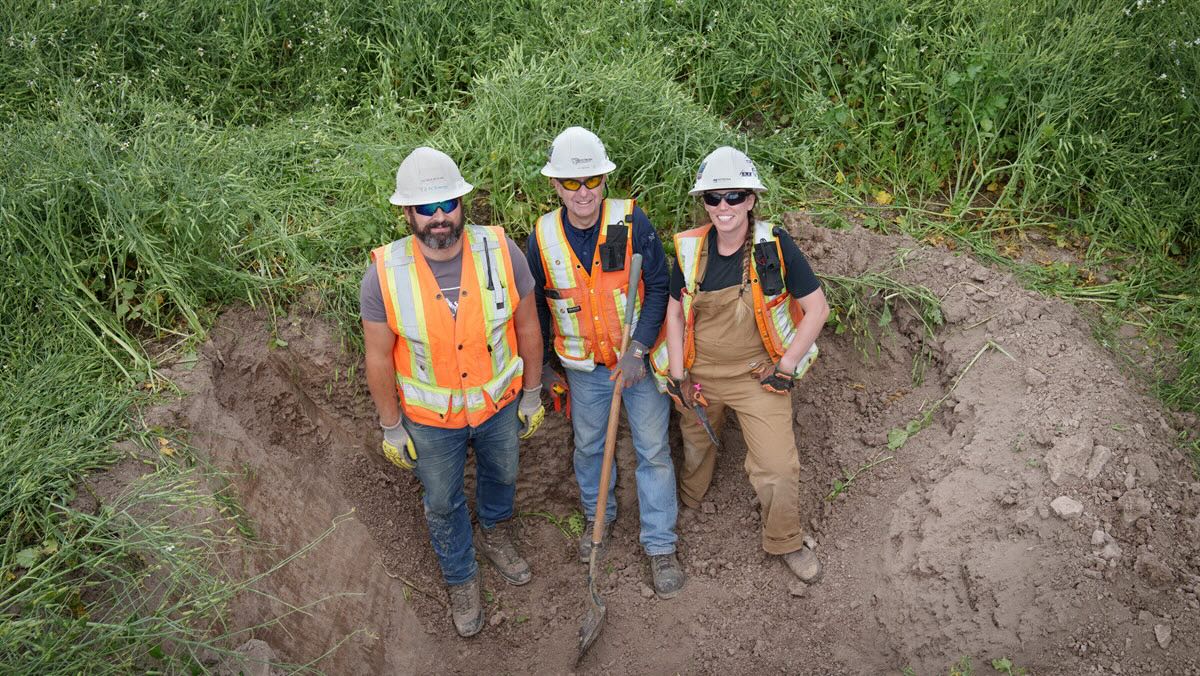Home>diy>Building & Construction>How Does Construction Help The Economy


Building & Construction
How Does Construction Help The Economy
Modified: March 6, 2024
Learn how building construction contributes to the economy and plays a vital role in job creation, economic growth, and infrastructure development. Discover the positive impact of construction on various sectors and industries.
(Many of the links in this article redirect to a specific reviewed product. Your purchase of these products through affiliate links helps to generate commission for Storables.com, at no extra cost. Learn more)
Introduction
The construction industry plays a crucial role in the overall development and growth of an economy. It encompasses various activities such as the construction of buildings, roads, bridges, and infrastructure that are essential for societal progress. Beyond creating physical structures, the construction sector has a significant impact on the economy through job creation, economic multiplier effects, and investment opportunities.
In this article, we will explore how construction contributes to the economy and examine the various ways in which it stimulates economic growth. We will also discuss the challenges faced by the construction industry and their potential implications for the overall economy.
So, let’s dive into the fascinating world of construction and its profound impact on the economy.
Key Takeaways:
- Construction creates jobs, boosts the economy, and connects communities through infrastructure development, contributing to overall prosperity and economic growth.
- Despite challenges like labor shortages and project delays, the construction industry offers diverse investment opportunities and plays a vital role in driving sustainable economic development.
Role of Construction in the Economy
The construction industry serves as a catalyst for economic development, playing a crucial role in creating jobs, generating income, and driving growth. It serves as the backbone of infrastructure development, providing the foundation for economic activities in various sectors.
Construction projects require a diverse range of skills, from architects and engineers to skilled laborers and contractors. By employing a large workforce, the construction sector creates employment opportunities, reducing unemployment rates and improving the overall standard of living.
Additionally, the construction industry has a significant economic multiplier effect. The construction of new buildings and infrastructure requires the procurement of raw materials such as steel, cement, and wood, creating a demand for these industries. This, in turn, leads to increased production, higher revenue, and job creation in the manufacturing sector.
Furthermore, the construction of infrastructure, such as roads, bridges, and airports, improves connectivity and accessibility. This facilitates trade, drives tourism, and attracts investment, contributing to the overall economic growth of a region or country.
The construction sector also has a direct impact on the Gross Domestic Product (GDP). Construction activities contribute to the productive output of an economy, adding value and creating assets. The value-added by the construction industry is reflected in the GDP, showcasing its significant role in economic performance.
Moreover, the construction industry presents lucrative investment opportunities. Investors can participate in construction projects by providing funding, material resources, or expertise. Investing in construction can yield substantial returns, generating profits and stimulating economic activity.
However, it is crucial to recognize the challenges that the construction industry faces, which can undermine its potential contributions to the economy. We will discuss these challenges and their implications in the next section.
Creation of Jobs
One of the most significant contributions of the construction industry to the economy is the creation of jobs. Construction projects require a diverse range of skills and labor, resulting in employment opportunities across various skill levels.
At the onset of a construction project, architects and engineers are needed to design the structure and ensure its feasibility. Skilled workers, such as carpenters, masons, plumbers, and electricians, are essential for the physical construction process. Additionally, project managers, supervisors, and administrative staff are needed to oversee and manage the entire project.
Due to the labor-intensive nature of construction work, it provides employment to both semi-skilled and unskilled workers. This aspect of the industry is particularly beneficial in developing economies, where there may be a surplus of low-skilled labor.
Furthermore, construction projects often create indirect employment opportunities beyond the construction site itself. The demand for raw materials, such as cement, steel, and timber, necessitates the involvement of various manufacturing industries. The transportation and logistics sectors also play a crucial role in the supply chain, ensuring the timely delivery of materials to the construction site. These indirect employment opportunities further contribute to job creation in the overall economy.
The construction industry’s role in job creation extends beyond the construction phase. Once the project is completed, there is a need for maintenance and operations, leading to the creation of long-term employment opportunities. For example, building maintenance staff, security personnel, and facility managers are required to ensure the proper functioning and upkeep of the constructed infrastructure.
Overall, the construction industry’s ability to create jobs has a significant impact on reducing unemployment rates and improving the overall socio-economic conditions of a country. By providing employment opportunities across various skill levels, it helps to uplift communities and contribute to economic growth.
Economic Multiplier Effect
The construction industry has a unique characteristic known as the economic multiplier effect, which refers to the phenomenon whereby economic activity in one sector stimulates activity in other related sectors, leading to a cascading impact on the overall economy.
When a construction project is initiated, it requires a significant amount of raw materials, such as cement, steel, and lumber. The demand for these materials increases, leading to a boost in production and sales for the manufacturing sector. This, in turn, generates additional income and employment opportunities for workers in the manufacturing industry.
The increased demand for construction-related materials and products also has a positive ripple effect on the transportation and logistics sector. The transportation of raw materials to construction sites and the delivery of finished construction materials require a well-functioning logistics network. This generates business and employment opportunities for transport companies, truck drivers, and other logistics service providers.
The construction industry’s impact extends beyond immediate materials and transportation needs. It also stimulates demand for various services, including architectural firms, engineering consultancies, legal services, and financial institutions. These industries provide specialized expertise and support to construction projects, fueling economic activity and creating employment opportunities in their respective sectors.
The economic multiplier effect is not limited to the construction phase alone. Once a construction project is completed, it often leads to the development of related businesses and service providers. For example, the construction of a new commercial building may attract businesses such as restaurants, retail stores, and offices. These businesses, in turn, create employment opportunities and generate economic activity in the surrounding area.
Overall, the economic multiplier effect of the construction industry plays a crucial role in driving economic growth and development. By generating demand for various industries and creating employment opportunities at multiple levels, it stimulates economic activity and enhances prosperity in the wider economy.
Infrastructure Development
Infrastructure development is a key component of economic growth and sustainability, and the construction industry plays a vital role in this process. Infrastructure refers to the essential physical structures that support economic activities and improve the quality of life for individuals.
The construction industry is responsible for building and maintaining various types of infrastructure, including roads, bridges, airports, railways, ports, and utilities. These infrastructure projects provide the foundations for economic activities in other sectors, such as transportation, trade, and energy.
Roads and highways are critical for connecting different regions and facilitating the movement of goods, services, and people. They reduce transportation costs, increase efficiency, and promote trade and economic integration. The construction of well-designed and well-maintained roads not only improves connectivity but also enhances safety and reduces travel time.
Bridges and tunnels play a vital role in overcoming geographical barriers, enabling smoother transportation and facilitating trade between regions. They enhance accessibility and connect communities, promoting economic development and social cohesion.
Airports are essential for national and international travel, promoting tourism, facilitating business transactions, and enabling the transportation of goods and services. The construction of airports, including runways, terminals, and related facilities, requires specialized expertise and creates employment opportunities in both the construction and aviation sectors.
Railway infrastructure is crucial for efficient transportation of goods and passengers, reducing congestion on roads and highways. The construction of railways, including tracks, stations, and signaling systems, improves logistics and boosts the overall efficiency of the transportation network. It also enhances connectivity and accessibility, promoting regional development and integration.
Ports and harbors are essential for international trade, facilitating the import and export of goods. The construction of port facilities, including berths, storage areas, and logistics infrastructure, supports trade activities and enhances the competitiveness of a country in the global market.
Utilities infrastructure, such as water supply systems, wastewater treatment plants, and power generation facilities, is crucial for sustainable development. The construction of these infrastructure projects ensures the availability of clean water, sanitary facilities, and reliable energy supply, which are essential for the functioning of industries, businesses, and households.
Overall, the construction industry’s involvement in infrastructure development is crucial for fostering economic growth, improving connectivity, enhancing productivity, and ensuring long-term sustainability. By creating and maintaining essential infrastructure, the construction sector plays a vital role in driving economic development and improving the quality of life for individuals and communities.
Construction helps the economy by creating jobs, stimulating demand for goods and services, and increasing property values. It also generates tax revenue for local and national governments.
Read more: How Does Humidifier Help Cough
Contribution to GDP
The construction industry makes a significant contribution to the Gross Domestic Product (GDP) of a country. GDP measures the total value of goods and services produced within a specific timeframe and serves as an indicator of economic performance.
Construction activities directly contribute to GDP through the value-added by the industry. Value-added refers to the increase in value that occurs during the production process. In the case of the construction sector, this includes the design, planning, construction, and maintenance of various structures and infrastructure.
When a construction project is undertaken, it involves the purchase of raw materials, equipment, and services from various sectors. This stimulates economic activity and generates revenue for these industries, contributing to overall GDP. For instance, the procurement of construction materials such as steel, cement, and wood creates demand for the manufacturing sector.
Additionally, the construction industry employs a significant number of workers at various skill levels. The wages earned by these workers contribute to household income, which, in turn, drives consumer spending. Increased consumer spending has a positive impact on GDP, as it reflects higher economic activity and demand for goods and services.
Moreover, the construction industry’s impact on GDP extends beyond its direct contributions. The infrastructure and buildings constructed by the industry serve as platforms for economic activities in other sectors. For example, commercial buildings provide space for businesses to operate and generate revenue. This, in turn, contributes to the GDP of not only the construction industry but also the sectors utilizing the infrastructure.
The construction industry’s indirect contributions to GDP can be seen in its influence on related sectors. For instance, the hospitality industry benefits from the construction of hotels and resorts, attracting tourists and generating revenue. Similarly, the retail sector benefits from the development of shopping malls, boosting consumer spending and economic activity.
Furthermore, the construction industry plays a significant role in attracting investment and fostering economic growth. Investors view a country’s infrastructure as a critical factor in their decision-making. Countries with well-developed infrastructure are more likely to attract foreign direct investment, which contributes to GDP through capital inflows and job creation.
The overall contribution of the construction industry to GDP can vary depending on the level of construction activity and infrastructure development in a country. However, it consistently remains a vital sector that drives economic growth, employment, and investment.
Investment Opportunities
The construction industry offers a wide range of investment opportunities, attracting both domestic and foreign investors seeking profitable ventures. Investing in construction projects can provide attractive returns and contribute to economic growth. Here are some key investment opportunities in the construction sector:
- Residential Real Estate: Investing in residential real estate, such as housing developments and apartment complexes, can be a lucrative opportunity. With the growing population and urbanization, there is a continuous demand for affordable and quality housing. Residential real estate investments provide a steady income stream through rental income or capital appreciation.
- Commercial Properties: Investing in commercial properties, including office buildings, retail spaces, and warehouses, can offer long-term stability and high returns. Commercial properties generate rental income and are attractive to businesses needing space for their operations. The demand for commercial properties tends to be resilient, especially in prime locations.
- Infrastructure Projects: Infrastructure development projects provide significant investment opportunities. Investing in the construction of roads, bridges, railways, airports, and ports can be highly profitable. These projects often involve partnerships between public and private entities, offering opportunities for public-private partnerships (PPPs) or concessions.
- Renewable Energy: The construction of renewable energy projects, such as solar farms, wind farms, and hydroelectric power plants, presents promising investment opportunities. With the growing focus on sustainability and the transition to clean energy sources, investing in renewable energy infrastructure can yield attractive returns while contributing to environmental goals.
- Industrial Facilities: Investing in the construction of industrial facilities, such as manufacturing plants, warehouses, and logistics centers, can be a strategic move. Industrial infrastructure supports businesses’ operational needs and plays a crucial role in supply chain management. As economies continue to grow and global trade expands, the demand for industrial facilities remains strong.
When considering investment opportunities in the construction industry, it is crucial to conduct thorough market research, analyze the potential risks and returns, and seek professional advice. Factors such as location, market demand, regulatory environment, and project feasibility should be carefully evaluated before making any investment decision.
Furthermore, investing in the construction sector can take different forms, including direct investments in specific projects, investments in construction-related stocks or bonds, or participation in real estate investment trusts (REITs) focused on construction and infrastructure assets.
It’s important to note that the construction industry can be influenced by market fluctuations, economic conditions, and regulatory changes. Therefore, investors should consider diversifying their portfolio and adopting a long-term perspective when investing in the construction sector.
Overall, the construction industry offers diverse and exciting investment opportunities. Investing in construction projects can not only generate financial returns but also contribute to job creation, economic development, and the improvement of infrastructure in a region or country.
Challenges Facing the Construction Industry
While the construction industry plays a vital role in the economy, it faces numerous challenges that can hinder its growth and overall contribution. Understanding and addressing these challenges is crucial for ensuring the industry’s sustainability and maximizing its potential impact. Here are some key challenges facing the construction industry:
- Project Delays and Cost Overruns: Construction projects often face delays and cost overruns due to various factors such as unforeseen site conditions, poor project management, and inadequate planning. These issues can lead to financial losses for construction companies and negatively impact the overall project timeline and budget.
- Skilled Labor Shortage: The construction industry is experiencing a shortage of skilled labor. As experienced workers retire and fewer young people enter the construction trades, there is a growing gap in the availability of skilled carpenters, plumbers, electricians, and other construction professionals. This shortage can lead to increased labor costs and project delays.
- Regulatory and Permitting Challenges: Construction projects often face complex and time-consuming regulatory and permitting processes. Obtaining necessary approvals and permits from governmental agencies can be a lengthy and bureaucratic process, causing delays and increasing project costs. Streamlining and improving the regulatory framework can help alleviate these challenges.
- Sustainability and Environmental Concerns: Construction activities have a significant impact on the environment. The industry faces increasing pressure to adopt sustainable practices, minimize waste, and reduce carbon emissions. Meeting these environmental standards can be challenging, requiring investments in eco-friendly technologies and materials.
- Technology Adoption: The construction industry has traditionally been slower in adopting new technologies compared to other industries. However, embracing technologies such as Building Information Modeling (BIM), drones, and 3D printing can improve project efficiency, collaboration, and sustainability. Encouraging technology adoption and providing training opportunities can help overcome this challenge.
- Safety and Health Risks: Construction sites present inherent safety and health risks for workers. Ensuring proper safety measures, providing training, and enforcing regulations are crucial to protect workers’ well-being. Addressing safety concerns and promoting a culture of safety is essential for the long-term success of the construction industry.
- Financial Risks and Funding: Construction projects often require significant upfront investments, and securing funding can be a challenge. Financing options, such as loans, grants, public-private partnerships, and investor partnerships, need to be explored to mitigate financial risks and support project development.
Addressing these challenges requires collaboration between government agencies, industry stakeholders, and construction companies. It involves implementing strategies to attract and train more skilled labor, improving project management practices, streamlining regulatory processes, promoting sustainability initiatives, embracing technology advancements, enhancing safety standards, and creating favorable financing conditions.
By proactively addressing these challenges, the construction industry can overcome barriers to growth and continue to contribute positively to the economy, job creation, and infrastructure development.
Conclusion
The construction industry plays a crucial role in the economy, contributing to job creation, economic growth, infrastructure development, and overall prosperity. Its impact extends beyond the physical structures it creates, encompassing various sectors and driving positive economic outcomes.
By creating job opportunities at different skill levels, the construction industry helps reduce unemployment rates and uplifts communities. It also has an economic multiplier effect, stimulating activity in related sectors and generating revenue and employment opportunities throughout the economy.
Infrastructure development is another key aspect of the construction industry, providing the foundation for economic activities in sectors such as transportation, trade, and energy. Well-designed and well-maintained infrastructure enhances connectivity, promotes regional development, and attracts investment, ultimately contributing to economic growth and stability.
The construction industry’s contributions are reflected in the Gross Domestic Product (GDP) of a country. The value-added by construction activities, along with its direct and indirect impacts on other sectors, showcases its significance in driving economic performance.
Investing in the construction sector offers lucrative opportunities for individuals and businesses. Residential and commercial real estate, infrastructure projects, renewable energy, and industrial facilities are among the many avenues for investment, providing potential returns and supporting economic development.
However, the construction industry also faces challenges that need to be addressed. Project delays, skilled labor shortages, regulatory complexities, sustainability concerns, technology adoption, and safety risks are some of the key obstacles that need attention and proactive solutions.
In conclusion, the construction industry is a critical pillar of the economy, with its contributions spanning job creation, economic growth, infrastructure development, and investment opportunities. By overcoming challenges and embracing innovation, the industry can continue to drive sustainable economic development, improve living standards, and shape the future of societies.
Frequently Asked Questions about How Does Construction Help The Economy
Was this page helpful?
At Storables.com, we guarantee accurate and reliable information. Our content, validated by Expert Board Contributors, is crafted following stringent Editorial Policies. We're committed to providing you with well-researched, expert-backed insights for all your informational needs.















0 thoughts on “How Does Construction Help The Economy”